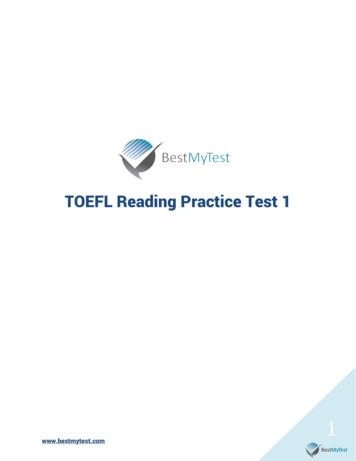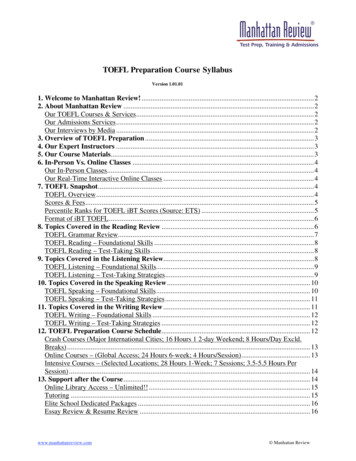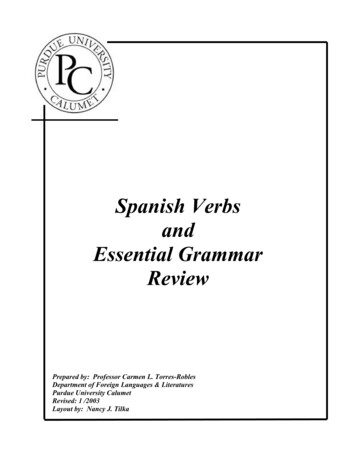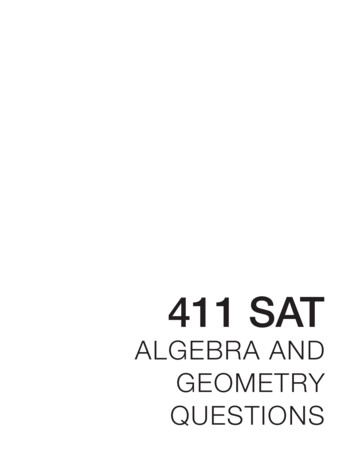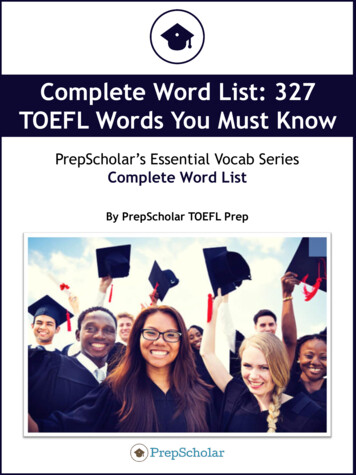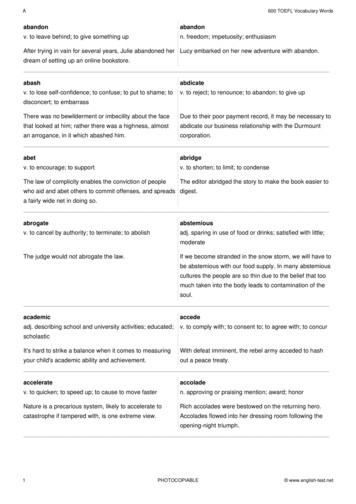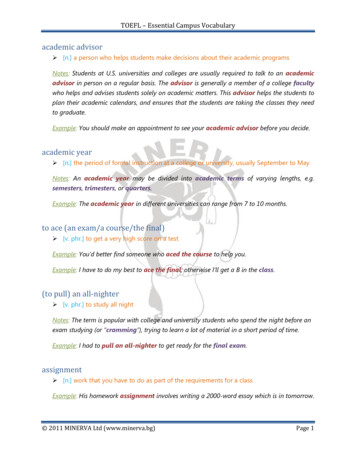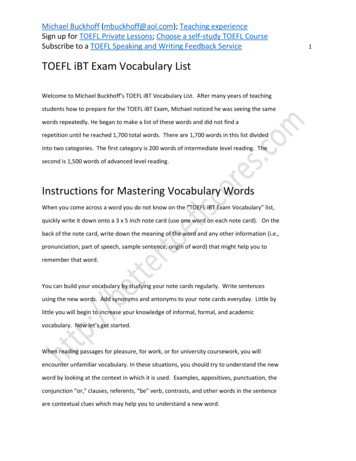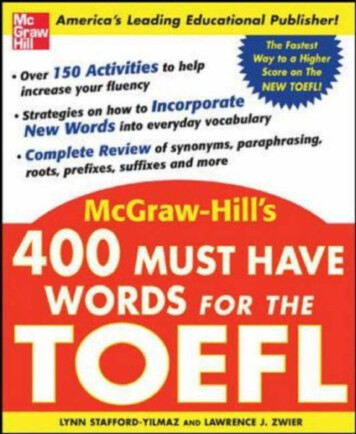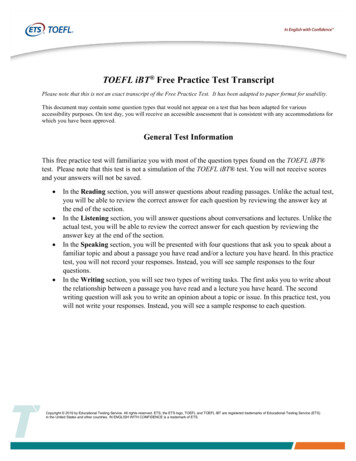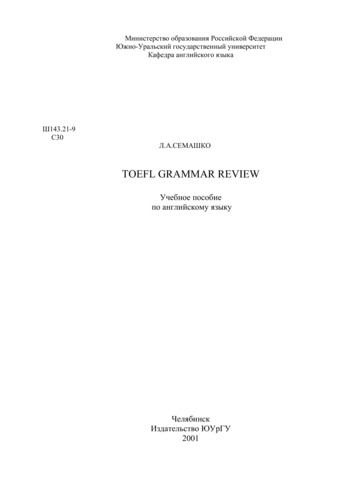
Transcription
Министерство образования Российской ФедерацииЮжно-Уральский государственный университетКафедра английского языкаШ143.21-9С30Л.А.СЕМАШКОTOEFL GRAMMAR REVIEWУчебное пособиепо английскому о ЮУрГУ2001
ББК Ш143.21-923TOEFL GRAMMAR REVIEW/ Семашко Л.А. Учебное пособие по английскому языку. –Челябинск: Изд-во ЮУрГУ, 2001. – 203 с.Учебное пособие предназначено для тех, кто хочет причести в систему иусовершенствовать знание граммтики английского языка до уровня, необходимого для сдачиэкзамена TOEFL (тест по английскому языку как иностранному), а также для широкого кругажелающих самостоятельно продолжить изучение английского языка.Пособие состоит из 5 частей, содержащих более 250 упражнений и тестов, направленныхна закрепление наиболее важных разделов грамматики. Приложение с ключами позволитиспользовать пособие, как на аудиторных занятиях, так и для самостоятельной работы.Список лит. – 13 назв.Одобрено учебно-методической комиссией факультета лингвистики.Рецензенты: М.Г. Федотова, О.И. Шубина.ISBN 5-696-02111-5 Издательство ЮУрГУ, 20012
CONTENTSPrefacePART I: British and American English1. Differences Between British English and American EnglishPART II: Grammar Review2. Sentence Pattern3. Nouns4. Count and Non-Count Nouns5. Articles6. Distinction Between OTHER / ANOTHER7. Tenses8. Subject— Verb Agreement9. Pronouns10. Verbs as Compliments11.Pronouns as Compliments12.The Verb NEED13. Questions:Information QuestionsEmbedded QuestionsTag Questions14. Negation15. Affirmative and Negative Agreement16. Conditional Sentences17. USED TO / USED TO Ving18. Would Rather19. Modals20. Adjectives and Adverbs21. Linking Verbs22. Comparisons23. Nouns Functioning as Adverbs24. Hyphenated Adjectives25. ENOUGH with Adjectives, Adverbs and Nouns26. Cause Connectors: BECAUSE / BECAUSE OF; SO / SUCH27. Passive Voice28. Causative Verbs29. Relative Clauses30. Subjunctive31. Inclusives: NOT ONLY.BUT ALSO, BOTH.AND, AS WELL AS32. KNOW/KNOW HOW33. Clauses of Concession: DESPITE / IN SPITE OF / ALTHOUGH34. Problem 6970747577788284879092939496
PART III: Style in Written English35. Sequence of Tenses36. SAY/TELL37. Antecedents of Pronouns38.The Pronouns ONE and YOU39.Illogical Participial Modifiers (Dangling Participles)40.Participles as Adjectives41. Redundancy42.Wordiness43.Parallel Structure44. Transformation of Direct and Indirect Objects45. InversionPART IV: Prepositions, Conjunctions and Problem Vocabulary46.Prepositions47. Conjunctions48.Vocabulary49. Structure and Written ExpressionTest 1Test 2PART V: IdiomsAnswer 36139162
PrefaceAt present many people want to study or to work abroad, or to work for a foreigncompany in Russia. The first step to achieve this goal is to pass the test which certifiesyour knowledge of English. For example, if your plans are connected with working orstudying in the USA, you have to pass the TOEFL (Test of English as a ForeignLanguage).The TOEFL is a timed test that consists of four sections:1. Listening Comprehension (50 questions — 40 minutes);2. Structure and Written Expression (40 questions — 25 minutes);3. Vocabulary and Reading Comprehension (50 questions — 55 minutes).4. Writing (30 minutes).The maximum total score is 300 points.In preparing for the TOEFL, or any other language examinations, it is veryimportant to review the language skills for each section of the examination and to havean opportunity to make model tests that are similar to the actual examination.Reviewing will help students recall some of the language skills that they have studied inprevious classes and other books.It is assumed that students have studied grammar prior to reviewing for theTOEFL, and that they are relatively fluent. The purpose of this workbook then, is toprovide students with a detailed review of the language skills for the Structure andWritten Expression section of the TOEFL, to sharpen these skills and to improveaccuracy.TOEFL Grammar Review is divided into five parts covering the most frequentlytested problems necessary to pass Section 2 of the TOEFL. Part I shows differencesbetween American and British English. Parts II-IV include practice exercises designedto improve the ability to recognize grammar and correct style in Written English. TwoTOEFL Structure and Written Expression Practice Tests included in Part IV will allowto measure their ability to answer grammar questions in the TOEFL format. Part Vcontains exercises testing American idioms.The TOEFL Grammar Review includes answer keys which enable to use thisworkbook as a self-study guide for independent out-of class work.5
PART I: BRITISH AND AMERICAN ENGLISH1. DIFFERENCES BETWEEN BRITISH ENGLISHAND AMERICAN ENGLISH1. [ju:]–[a][i][u:][r][d]ttssschde- ureNOTE:Beforen [t][t][t ][s] [ ][z] [ ][sk] [ ][d] [d][ε] [i:][ ] [][t]2. SPELLINGBE- ourcolourfavourhumourvapour- re- llcentretheatremetretravellerjewelleryExamplesask, dance, half, grass, example, can'tatehot, not, top, stop, problemprivacy, either, neither, vitamindue, news, knew, tunereader, figurelittle, city, cottage, auto, pretty, utter,critic, party, water, forget itbutton, mountain, writtensituationissueas you know, becausescheduleeducation, would you, could youleisurefigureAE- orcolorfavorhumorvapor- recentertheatermeter-ltravelerjewelry6
marvellouscancelledmarvelouscanceled- encedefenceoffencelicence- ensedefenseoffenselicense- oguecataloguedialoguemonologue- ogcatalogdialogmonolog- ppworshippedkidnapper-pworshipedkidnaper- ram- iserecognise- jamasthrutirecopysleafs7
3. earch'secretary'tele visionBEaccumulatorautumnbarristerbiscuitblock of neycake, cookieapartment housedrugstoreFrench friesmovie theaterovendrapesapartmentyardcorn trolpicturespostpuncturequeuereturnring usersundergroundundershirtwardrobeAEsidewalkgas, gasolinemoviemailblow- outlineround tripcall uperasergarbagestoreliquorlast ightpants, slackssubwayvestcloset4. VOCABULARY5. GRAMMARBE1. Present PerfectI have just had lunch.AEPast SimpleI just had lunch.8
I have already posted the letter.I haven't told them.I already mailed the letter.I didn't tell them about it yet.2. Future Perfect (Progressive)What will you have done by thetime you go to bed tonight?How long will you have beendoing that?Future SimpleWhat will you do by the timeyou go to bed tonight?How long will you do that?3. I've gotI haven't gotHave you got?I haveI don't haveDo you have?4. QuestionsDo you know anything?Have you ever been to London?Do you need a j ob?You know something?Ever been in London?Need a j ob?5. hospitalin a teamat the week-end/at week-endsdifferent towrite to someonethe hospitalon a teamon the week-end/on week-endsdifferent thanwrite someone6. Irregular prove-proved-provedburn- ove-proved-proven7. ShouldI demand that I should bereleased.SubjunctiveI demand that I be released.6. COLLOQUALISMSBEAEBEAEYesNoYouhave todon't yougoing toYep, Yup, YeahNope, Naw, HahYahaftadon'tchagonnawant tohave got (have)let meout ofgive meI don't knowwannagottalemmeouttagimmieI dunno9
Exercise 1. Match the words in American English on the left with their Britishequivalents on the right.AE1. apartment2. candy3. cookies4. drapes5. elevator6. eraser7. faucet8. flashlight9. French fries10. garbage11. purse12. vestBE1. lift2. chips3. handbag4. undershirt5. rubber6. rubbish7. sweets8. biscuits9. tap10. flat11. torch12. curtainesExercise 2. Match the words in American English on the left with their Britishequivalents on the right.AEBE1. baggage1. holiday2. blow-out2. telegramme3. gasoline3. garden4. round trip4. pavement5. line5. luggage6. sidewalk6. label7. subway7. petrol8. tag8. underground9. truck9. queue10. vacation10. puncture11. wire11. lorry12. yard12. return10
PART II: GRAMMAR REVIEW2. SENTENCE PATTERNExercise 3. Identify the subject, verb, compliment, and modifier in each of thefollowing sentences.1. Our neighbor's dog barked all afternoon.2. Our walking group meets at seven o'clock in the morning.3. The band played all evening.4. June speaks at almost every staff meeting.5. Mrs. Perez bought a new rug for her dining room.6. Some cough medicines contain alcohol.7. Bill carried his tools in a five- gallon plastic bucket.8. Linda often buys snacks at the university store.9. All of the buses are equipped with safety belts.10.Paulette wore the same brand of blue jeans for twenty years.11. Several inches of water flooded the basement of the library during the night.12.Martin orders all his clothes from catalogues.13.A typical supermarket sells more than 18,000 products.14. One flea can lay 500 eggs.15.A dangerous situation exists in the Near East.16.Elliot first met Olivia in the snack section of a supermarket.17.Mr. Pandolfo wrote his own will.18.My new English class meets three times a week.19.Ellain wanted to get a new hat at the store.Exercise 4. Identify the part of speech of each word in the following sentences:noun, verb, adjective, adverb, article,conjunction, preposition, pronoun1. The tiny island is surrounded by a spectacular body of water.2. My pen is running out of ink.3. I always wanted to go to that show.4. Did you enjoy the party the other night?5. My computer program is faulty.6. The costumes in the pageant are almost as beautiful as the contestants.7. The Paseo Del Rio runs along the San Antonio River in the heart of the city.8. A beautiful photograph is a wonderful souvenir of an event.9. You don't need to read all the information to get the question right.10. My sister was thrilled to be invited.11 .In addition to being weatherproof, the new camera features a remote control.11
12. The largest film festival in the world, the Houston International Film Festival,boasts 3,500 entries.13. The main attraction of the new restaurant is the salad bar.14. After deciding to go out and play, Gwen located her jacket.15.The arboretum in our town has some beautiful pine trees.16. Unlike those in the neighboring school, our teachers are quite flexible.17. The bus was so late that we missed school.18. The county fair is a lot of fun.19. Leslie hid the dirty dishes in a cabinet before her mother came into the kitchen.20. Pay's recipe for baked beans is famous in our neighborhood.3. NOUNSIrregular Plurals1) Words with Two Acceptable Plural rfstornadoesvertebraevolcanoeswharfszeroes12
2) Common Irregular es4. COUNT AND NON- COUNT NOUNSExercise 5. Identify the types of nouns underlined in the sentences below Count (C)- Non - Count (N).1. Ethan can operate his camera with only one hand.2. Whipped butter contains fewer calories per serving than ordinary butter.3. Randy installed a dashboard fan that runs on the power from his car's cigarettelighter.4. His childhood was ordinary, if a little lonely.5. The jacket is long enough to wear as a dress.6. Fish and chicken are good for people with high cholesterol.7. I didn't have much luggage - just two small bags.13
8. Some people who have every pillow fluffed and in its proper place in their roomsnever make an effort to organize their closets.9. For her class Juanita created a gigantic collage that included old shoes, silverware,and clippings from newspapers.10. Interesting baskets can be made of straw, bark or roots.11. Osteoporosis is the abnormal loss of bone.12. Vera's salsa was delicious and contained very few calories.13. Customers are not in the mood to accept major changes in styles of clothing.14. Shorter campaigns make voters more interested in politics.15. After a long, lonely winter, the ugly duckling emerged as a beautiful swan.16. Clutter can make a room seem smaller.Exercise 6. Give the plurals of these nouns.1. sand5. accountancy2. decision6. electricity3. furniture7. architecture4. age8. soapExercise 7. Underline the correct determiner.1. There are (less / fewer) chairs in this room than in the other room.2. The assistant didn't give (much / many) information.3. After the negotiations, they made (little / few) changes in their proposal.4. (A large amount of/A great number of) mosquitoes appea
toefl grammar review/ Семашко Л.А. Учебное пособие по английскому языку. – Челябинск: Изд-во ЮУрГУ, 2001. – 203 с. Учебное пособие предназначено для тех, кто хочет причести в систему и усовершенствовать знание граммтики английског
